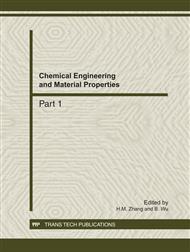p.505
p.511
p.517
p.524
p.530
p.535
p.540
p.545
p.549
Study on the Properties of Poly(lactic acid)/Starch/Chitosan Blended Materials
Abstract:
Former researchers have studied the properties of PLA/starch blended materials, but the influence of chitosan for them has not been studied yet. In this paper, it prepared the blended materials of PLA/starch/chitosan, and studied the compatible, mechanical and thermal properties of them. The results demonstrated that, since chitosan molecules had hydroxy and amino groups, which could form molecular force with the hydroxy groups in starch molecules and the carbonyl groups in PLA molecules respectively, the addition of it would improve the compatibility of PLA and starch. The SEM surface and section photos of blended materials could prove this compatibility, and the mechanical properties of blended materials also certified it. Specifically, with the addition of chitosan, the elongation, tensile modulus and tensile strength were all increase. For thermal properties, the addition of chitosan had no influence on it.
Info:
Periodical:
Pages:
530-534
Citation:
Online since:
December 2011
Authors:
Price:
Сopyright:
© 2012 Trans Tech Publications Ltd. All Rights Reserved
Share:
Citation:


